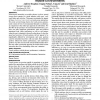Free Online Productivity Tools
i2Speak
i2Symbol
i2OCR
iTex2Img
iWeb2Print
iWeb2Shot
i2Type
iPdf2Split
iPdf2Merge
i2Bopomofo
i2Arabic
i2Style
i2Image
i2PDF
iLatex2Rtf
Sci2ools
CHI
2011
ACM
2011
ACM
Experimental analysis of touch-screen gesture designs in mobile environments
Direct-touch interaction on mobile phones revolves around screens that compete for visual attention with users‟ realworld tasks and activities. This paper investigates the impact of these situational impairments on touch-screen interaction. We probe several design factors for touch-screen gestures, under various levels of environmental demands on attention, in comparison to the status-quo approach of soft buttons. We find that in the presence of environmental distractions, gestures can offer significant performance gains and reduced attentional load, while performing as well as soft buttons when the user‟s attention is focused on the phone. In fact, the speed and accuracy of bezel gestures did not appear to be significantly affected by environment, and some gestures could be articulated eyes-free, with one hand. Bezel-initiated gestures offered the fastest performance, and mark-based gestures were the most accurate. Bezel-initiated marks therefore may offer a promising approach fo...
CHI 2011 | Environmental Demands | Human Computer Interaction | Information Interfaces | Soft Buttons |
| Added | 25 Aug 2011 |
| Updated | 25 Aug 2011 |
| Type | Journal |
| Year | 2011 |
| Where | CHI |
| Authors | Andrew Bragdon, Eugene Nelson, Yang Li, Ken Hinckley |
Comments (0)

